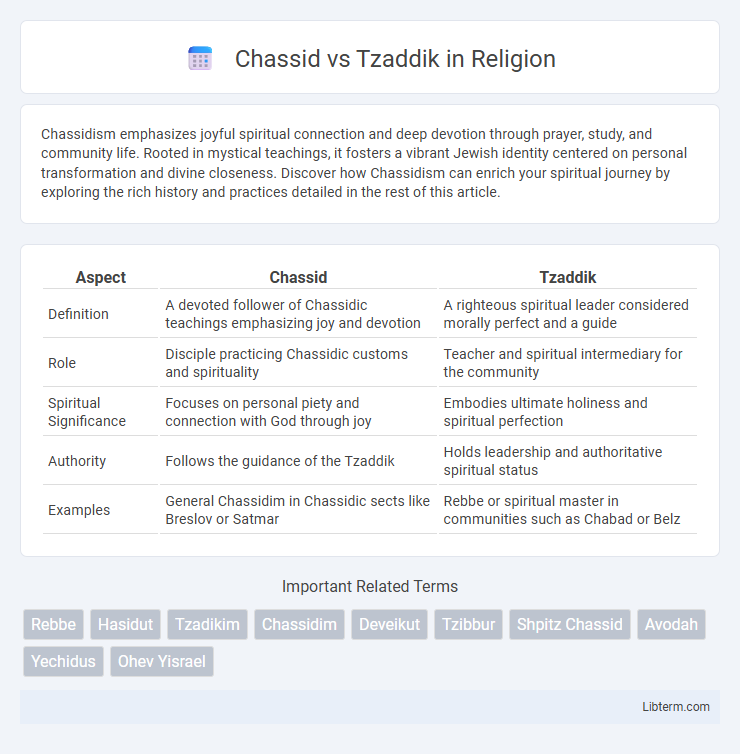Chassidism emphasizes joyful spiritual connection and deep devotion through prayer, study, and community life. Rooted in mystical teachings, it fosters a vibrant Jewish identity centered on personal transformation and divine closeness. Discover how Chassidism can enrich your spiritual journey by exploring the rich history and practices detailed in the rest of this article.
Table of Comparison
| Aspect | Chassid | Tzaddik |
|---|---|---|
| Definition | A devoted follower of Chassidic teachings emphasizing joy and devotion | A righteous spiritual leader considered morally perfect and a guide |
| Role | Disciple practicing Chassidic customs and spirituality | Teacher and spiritual intermediary for the community |
| Spiritual Significance | Focuses on personal piety and connection with God through joy | Embodies ultimate holiness and spiritual perfection |
| Authority | Follows the guidance of the Tzaddik | Holds leadership and authoritative spiritual status |
| Examples | General Chassidim in Chassidic sects like Breslov or Satmar | Rebbe or spiritual master in communities such as Chabad or Belz |
Defining Chassid and Tzaddik: Key Differences
A Chassid is a devoted follower who fervently practices Jewish spirituality and moral conduct, emphasizing humility and piety, while a Tzaddik is recognized as a righteous individual possessing exceptional spiritual insight and leadership qualities. The Chassid seeks to emulate the Tzaddik, who serves as a spiritual guide and intermediary between God and the community. Key differences lie in the Chassid's role as a disciple dedicated to growth versus the Tzaddik's status as a divinely inspired figure embodying holiness and wisdom.
Historical Origins of Chassid and Tzaddik
The Chassid movement originated in 18th-century Eastern Europe as a spiritual revival led by Rabbi Israel Baal Shem Tov, emphasizing piety, joy, and mysticism in Jewish life. The term Tzaddik, meaning "righteous one," historically referred to a spiritual leader or saintly figure who serves as an intermediary between God and the community in Hasidic thought. The Chassidim followed the Tzaddik as a central figure, whose role evolved to embody both spiritual guidance and communal leadership within the Hasidic movement.
Spiritual Roles in Hasidic Thought
In Hasidic thought, a Tzaddik serves as a spiritual leader and intercessor, channeling divine energy and guiding followers toward higher levels of piety and connection with God. The Chassid is a devoted follower who seeks to emulate the Tzaddik's righteousness and internalize spiritual teachings through prayer, joy, and simple faith. This dynamic highlights the reciprocal relationship where the Tzaddik's elevated spiritual status empowers the Chassid's personal growth and communal sanctity.
Chassid: The Devoted Follower
A Chassid is a devoted follower who actively embraces the teachings and spiritual practices of a Rebbe, seeking to deepen personal connection with the Divine through heartfelt prayer and joyful observance. Chassidim emphasize humility, unwavering faith, and the continuous pursuit of holiness in everyday life, embodying the values taught by the Tzaddik, or righteous leader. Unlike the Tzaddik, who serves as a spiritual guide and exemplar, the Chassid's role centers on faithful adherence and growth within the Chassidic community.
Tzaddik: The Righteous Leader
The Tzaddik, often regarded as the righteous leader in Jewish mysticism, embodies spiritual perfection and serves as a conduit between the divine and the community. Unlike a Chassid, who is a devoted follower committed to Torah and mitzvot observance, the Tzaddik holds a role of guidance, inspiration, and intercession, believed to possess heightened spiritual insight and holiness. The concept of the Tzaddik is central in Hasidic thought, where this righteous figure facilitates spiritual elevation and connects followers to divine blessings.
Pathways to Holiness: Chassidic vs. Tzaddik Approaches
Chassidic teachings emphasize joyful devotion, personal spiritual growth, and heartfelt prayer as pathways to holiness, inspiring followers to connect deeply with God through everyday actions. In contrast, the Tzaddik approach centers on the spiritual authority of the righteous leader, who serves as an intermediary, channeling divine blessings and guiding the community toward sanctity. Both pathways highlight distinct methods within Judaism for achieving closeness to the Divine, with Chassidim focusing on individual spiritual elevation and Tzaddikim embodying the communal role of spiritual intercession.
Community Perspectives on Chassid and Tzaddik
Community perspectives on the Chassid center around devoted followers who embody the teachings and practices of Hasidic Judaism, characterized by fervent spirituality and communal support. The Tzaddik is revered as a righteous leader and spiritual guide, often seen as an intermediary between the divine and the community, providing blessings and wisdom. Together, the Chassid and Tzaddik form a symbiotic relationship where communal identity and spiritual elevation are deeply intertwined.
The Chassid’s Relationship with the Tzaddik
The Chassid's relationship with the Tzaddik is deeply rooted in spiritual guidance and devotion, where the Tzaddik serves as a righteous leader embodying divine wisdom and holiness. This bond enables the Chassid to access elevated spiritual realms and receive personalized teachings that enhance their religious growth and connection to God. The dynamic reflects a profound trust and commitment, as the Tzaddik intercedes on behalf of the Chassid, fostering a communal sense of sanctity and spiritual elevation.
Teachings and Influence in Jewish Mysticism
Chassidim follow the teachings of the Tzaddik, who serves as a spiritual guide and exemplar in Jewish Mysticism, often emphasizing personal piety, joy, and the divine presence in everyday life. The Tzaddik's influence extends through mystical interpretations of the Torah and Kabbalah, shaping the communal practices and ethical conduct of Chassidic followers. This dynamic fosters a deep connection between the mystical insights of Kabbalah and practical spirituality, highlighting the Tzaddik's role in transmitting esoteric wisdom to the Chassidim.
Modern Interpretations of Chassid and Tzaddik
Modern interpretations of Chassid emphasize a devoted follower actively engaging in spiritual growth through joy, prayer, and community, reflecting the teachings of the Baal Shem Tov. In contrast, the Tzaddik is viewed as a righteous spiritual leader or mentor embodying divine connection and offering guidance and blessings. Contemporary Hasidic thought often highlights the dynamic relationship between the Chassid's personal devotion and the Tzaddik's role as a conduit of higher spiritual energy.
Chassid Infographic

 libterm.com
libterm.com